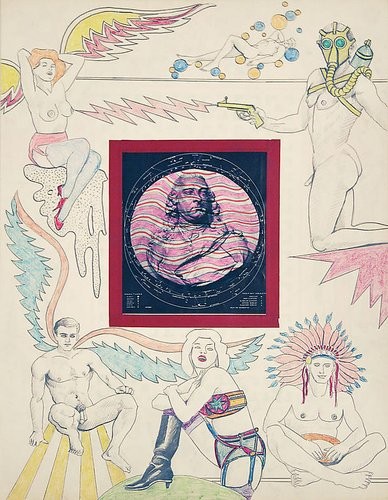Robert Smithson
03 - 07 Dec 2008
ROBERT SMITHSON
"POP Works, 1961-64"
December 3 - 7, 2008
New York Gallery
Robert Smithson: POP Works, 1961-64 highlights a rare body of work by Robert Smithson that is seldom seen outside of major institutional exhibitions. Influenced by the cultural landscape of the early sixties, particularly the burgeoning Pop Art movement, these works pre-date more familiar works such as the non-site objects and the seminal, outdoor earthworks. This significant body of work derived its ideas and imagery from a pastiche of science fiction, B-grade films, the then-seedy environment of New York's 42nd street, sexuality, nature, mythology, religion, and technology. Smithson's keen interest in all facets of popular culture would, in his later years, drive his investigations of the radical edge of mainstream culture as well as the white box of the gallery space.
In Smithson's hands, Pop took on a more personal and quirky tone than the cool formality of Warhol's silkscreens. His sculpture, The Machine Taking a Wife, 1964, employs a found photograph of a pinup girl, affixed to a psychedelic background, on which a rudimentary electric apparatus has been attached to the image of the woman. Seductive, humorous, and foreboding, the machine has visually and literally "taken" the woman, alluding to the femme fatales of cult films such as The Bride of Frankenstein as well as making highbrow reference to Marcel Duchamp's The Bride Stripped Bare by her Bachelors, (1915-23).
Even collage works such as Untitled (Second Stage Injector), 1963, and Algae, Algae, c. 1961-63, like the aforementioned sculptures, employ humor and psychedelic imagery to reference utopian ideals and the drug-induced haze of 1960s counterculture. Cartoon-like Algae, Algae uses language as a visual tool, with its accumulation of text suggesting the movement of the sea's waves. Such a reference to nature prefigures the later earthworks, as well as Smithson's writings on entropy and the landscape. His interest in text and concrete poetry led him to further explore the visual possibilities of language, culminating in his seminal drawing, A Heap of Language, 1966.
The notion of the rarefied sublime is completely debunked in Smithson's early Pop works. By combining low-brow references, kitsch religious imagery, and high-art quotations, Smithson developed a visual cornucopia in which Jesus was sexy and bikers were godlike. Nasty and funny, these early work hint at the future Smithson, who would continue to break rules and transgress boundaries. Smithson's freewheeling style and polymorphous iconography continues to resonate with a younger generation of artists working today.
James Cohan Gallery is the sole representative of the Estate of Robert Smithson.
"POP Works, 1961-64"
December 3 - 7, 2008
New York Gallery
Robert Smithson: POP Works, 1961-64 highlights a rare body of work by Robert Smithson that is seldom seen outside of major institutional exhibitions. Influenced by the cultural landscape of the early sixties, particularly the burgeoning Pop Art movement, these works pre-date more familiar works such as the non-site objects and the seminal, outdoor earthworks. This significant body of work derived its ideas and imagery from a pastiche of science fiction, B-grade films, the then-seedy environment of New York's 42nd street, sexuality, nature, mythology, religion, and technology. Smithson's keen interest in all facets of popular culture would, in his later years, drive his investigations of the radical edge of mainstream culture as well as the white box of the gallery space.
In Smithson's hands, Pop took on a more personal and quirky tone than the cool formality of Warhol's silkscreens. His sculpture, The Machine Taking a Wife, 1964, employs a found photograph of a pinup girl, affixed to a psychedelic background, on which a rudimentary electric apparatus has been attached to the image of the woman. Seductive, humorous, and foreboding, the machine has visually and literally "taken" the woman, alluding to the femme fatales of cult films such as The Bride of Frankenstein as well as making highbrow reference to Marcel Duchamp's The Bride Stripped Bare by her Bachelors, (1915-23).
Even collage works such as Untitled (Second Stage Injector), 1963, and Algae, Algae, c. 1961-63, like the aforementioned sculptures, employ humor and psychedelic imagery to reference utopian ideals and the drug-induced haze of 1960s counterculture. Cartoon-like Algae, Algae uses language as a visual tool, with its accumulation of text suggesting the movement of the sea's waves. Such a reference to nature prefigures the later earthworks, as well as Smithson's writings on entropy and the landscape. His interest in text and concrete poetry led him to further explore the visual possibilities of language, culminating in his seminal drawing, A Heap of Language, 1966.
The notion of the rarefied sublime is completely debunked in Smithson's early Pop works. By combining low-brow references, kitsch religious imagery, and high-art quotations, Smithson developed a visual cornucopia in which Jesus was sexy and bikers were godlike. Nasty and funny, these early work hint at the future Smithson, who would continue to break rules and transgress boundaries. Smithson's freewheeling style and polymorphous iconography continues to resonate with a younger generation of artists working today.
James Cohan Gallery is the sole representative of the Estate of Robert Smithson.

